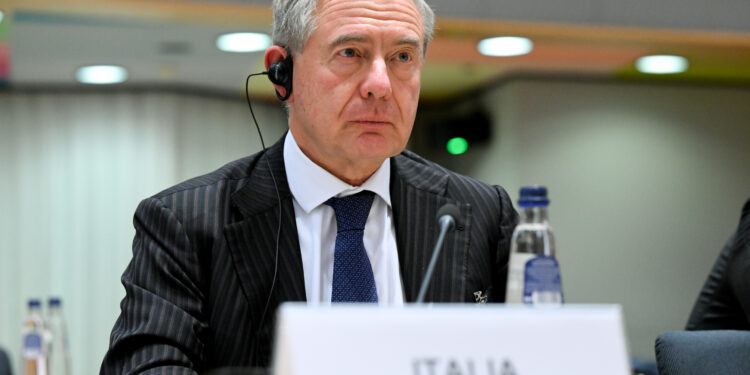Brussels – The automotive industry is the sector “that most feels the need to revise the path towards the green deal,” according to Adolfo Urso, Minister of Enterprise and Made in Italy. The revision can materialize if Italy succeeds in making its voice heard in the next institutional cycle, building on the indications that Mario Draghi provided in his report on European competitiveness. A pivotal date will be Thursday (Sept. 26), when Urso will ask his colleagues in Brussels to bring forward to 2025 the evaluation – scheduled for 2026 – on putting to an end combustion engines by 2035. At the EU Council, Germany should back Italy for the umpteenth time.
The future of industrial policy
Speaking on Monday (Sept. 23) at a roundtable with business associations and trade unions, the MIMIT incumbent outlined the government’s priorities on industrial policy. “I believe that something more and better can be done” in Brussels on green legislation, he said, especially now that the composition of the European Parliament and Commission has changed (with more representation of political forces skeptical about environmental policies). Italy has seen a “significant role assigned to Commissioner Raffaele Fitto.” Therefore, our country can “count” and influence the new course in the EU.
Moreover, the new course should start from the guidelines drawn by an Italian of excellence, former premier Mario Draghi, who recently presented a much-awaited report on the future of the Union’s competitiveness in which he wrote of “the risk that decarbonization is contrary to competitiveness and growth.” Urso called the report “extremely significant” and suggested the automotive industry follow the path indicated by the former ECB number one.
According to the Fratelli d’Italia minister, the time has finally come to “align industrial policy with environmental policy” (which until now have been “totally disconnected”) to avoid what the Italian and European right-wing consider sterile ideologism, if not outright dangers for business. The eco-foolishness of Brussels must be stopped and replaced with a “simplification shock” at the regulatory level, just as Draghi suggested, to prevent excessive constraints on companies.
The battle over emissions (and the Rome-Berlin axis)
It means, among other things, revising the now infamous EU vehicle CO2 emissions regulation framework, part of Fit for 55 (a cornerstone of the Green Deal), which marks the definitive stop to combustion engines by 2035. Specifically, the Italian government would like to bring forward to the first half of 2025 the mid-term review of the standards, initially set for the end of 2026 (for light vehicles, while for heavy ones, the date is 2027). By that date, the EU executive will need to assess progress toward meeting emission reduction targets and possibly recalibrate them in light of technological developments that have taken place in the interim.
Among the innovations Italy would like to count among the resources to use after 2035 are biofuels. Rome has been conducting this battle for some time but, so far, has failed to win. Technological neutrality, the head of MIMIT reiterated, is an issue to address without taboos. Urso will announce on Wednesday (Sept. 25) his proposal in Brussels, during an event on the future of the automotive industry sponsored by the Hungarian presidency of the Union, to then repeat it to his counterparts from the 27 Member States at the Competitiveness Council scheduled for the following day, the agenda of which includes a debate on industrial policy in the single market.
Germany (again), which has long blocked approval of the emissions measure until it obtained guarantees on so-called synthetic fuels, should back Italy. German Economy Minister Robert Habeck said he agreed to bring forward the review to next year to prevent the auto industry from facing multibillion-dollar penalties if it fails to meet the intermediate reduction targets the Commission set for 2025, again as part of the Fit for 55, drafted in 2019 and approved three years later. With the legislation in place, various categories of vehicles would have to cut carbon dioxide emissions by 15 percent from 2021 levels already next year
Habeck’s reasoning, which is then the same as Urso’s and of most companies in the industry, is that conducting the review before the new targets go into effect would allow reformulating them, considering several factors not contemplated five years ago. Several trends concern industry and governments, including China’s economic slowdown, declining European sales, and Beijing’s unfair competition in the electric car market (for which Brussels is on the verge of a duty war against China). There are some differences between the positions of Rome and Berlin, with the latter, unlike Italy, not opposing the ban on internal combustion engines to 2035 out of partisanship and not necessarily wishing to water down the targets to 2025.
The Berlaymont Palace, for the time being, is stilll like a rubber wall: the EU executive recently rejected calls to bring forward the review to next year, arguing that car manufacturers have already had five years to adapt to the legislation. “2026 is the time when the review clause is set in the legislation” EU zero-emissions legislation from 2035, Energy Commission spokesman Tim McPhie said today. “I think for now it is the most appropriate date.” We will have to see whether the faction of “rebel” states will confront Brussels head-on or whether a compromise solution between the opposing claims is possible. There could be a preview at Thursday’s Council.
English version by the Translation Service of Withub





